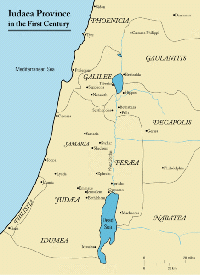Judah haNasi
- "Rebbi" redirects here.

Rabbi Judah haNasi, (Hebrew: יהודה הנשיא, pronounced Yehuda haNasi, "Judah the Prince"), also known as "Rabbi" and "Rabeinu HaKadosh" (Hebrew: רבינו הקדוש, "our holy rabbi"), was a key leader of the Jewish community of Judea toward the end of the 2nd century AD, during the occupation of the Roman Empire. He is best known as the chief "editor" or "redactor" of the Mishnah. He was of the Davidic line, the royal line of King David, hence the title "Prince."[1] The title nasi means president of the Sanhedrin.[2]
Biography
Judah haNasi was born in 135. According to the midrash, he came into the world on the same day that Rabbi Akiva died a martyr's death (Midrash Genesis Rabbah lviii.; Midrash Eccl. Rabbah i. 10) The Talmud suggests that this was a result of Divine Providence: God had granted the Jewish people another leader of great stature to succeed Rabbi Akiva. His place of birth is unknown; nor is it recorded where his father, Shimon ben Gamliel II, sought refuge with his family during the persecutions under Hadrian.
On the restoration of order in the Land of Israel, Usha became the seat of the academy and Judah spent his youth there. His father presumably gave him the same education that he himself had received, including Greek (Talmud Sotah 49b). This knowledge of Greek enabled him to become the Jews' intermediary with the Roman authorities. He favored Greek as the language of the country over Syriac (Aramaic) (Sotah, ibid). It is said that in Judah's house, only Hebrew was spoken and even the maids spoke it (Meg. 18a; R. H. 26b; Naz. 3a; 'Er. 53a).
According to the Talmud (Avodah Zarah 10a-b), Rabbi Judah the Prince was very wealthy and greatly revered in Rome. He had a close friendship with "Antoninus," possibly the Emperor Antoninus Pius,[3] who would consult Rabbi Judah on various worldly and spiritual matters.
The Talmud records the tradition that Rabbi Judah haNasi was buried in the necropolis of Beit She'arim, in the Lower Galilee.[4]
Compiler of the Mishna
| Rabbinical Eras |
|---|
According to Jewish tradition, God gave the Jewish nation the Written Law - Torah - and revealed to Moses additional laws and customs, called the Oral Law. For centuries, only the Torah appeared as a written text. Fearing that the oral traditions might be forgotten, Rabbi Judah Hanasi undertook the mission of compiling them in what became known as the Mishna. The Mishna consists of 63 tractates codifying Jewish law, which are the basis of the Talmud.
Talmudic legends
In the Talmud (Bava Metziah 85a), one of the most prominent rabbis is Judah haNasi, often referred to as "Rabbi." The title "Nasi" is often translated as "Prince," but in modern Hebrew, it is translated as "President."
Various stories are told about Judah HaNasi, to illustrate different aspects of his character. One of them tells of a calf being led to slaughter that broke free and tried to hide under Judah HaNasi's robes, bellowing with terror. Yehuda pushed the animal away, saying: "Go; for this purpose you were created."
In Heaven it was said: "Since he showed no pity, let us bring suffering upon him." Judah HaNasi was afflicted with kidney stones, painful flatulence and other gastric problems. He prayed for relief, but his prayers were ignored, just as he had ignored the pleas of the calf.
One day, Judah HaNasi's maid found some baby weasels in the house and was about to expel them violently with her broom. But Judah HaNasi stopped her, saying "Leave them alone! It is written: 'His Mercy is upon all his works.'"
And from Heaven was heard: "Since he has shown compassion, let us be compassionate with him." The rabbi was then healed of his painful illnesses and of his flatulence and could once again go out in public.
Rabbi Judah HaNasi also said "One ignorant of the Torah should not eat flesh" - possibly as a result of these experiences.
Notes
- ↑ Talmud Yerushalmi, quoted in Tosafos, Sanhedrin 5a
- ↑ Mishna Chagiga 2:2
- ↑ A. Mischcon, Abodah Zara, p.10a Soncino, 1988. Mischcon cites various sources, "SJ Rappaport... is of opinion that our Antoninus is Antoninus Pius." Other opinions cited suggest "Antoninus" was Caracalla, Lucius Verus or Alexander Severus.
- ↑ Babylonian Talmud (Talmud Bavli), Tractate Bava Metzia 85a, Tractate Pesachim 49b; Jerusalem Talmud, Tractate Kelaim 9, 32a-b.
ReferencesISBN links support NWE through referral fees
| Preceded by: Shimon ben Gamliel II |
Nasi 165 (Est.) - 220 |
Succeeded by: Gamaliel III |
| ||||||||||||||||||||||||||||||||||||||||||||||||||||||||||||||||||||||||||||||||||||||||||||||||||||||||||||||||||||||||||||||||||||||||||||||||||||||||||||||||||||||||||||||||||||||||||||||||||||||||||||||||||||||||||||||||||||||||||||||||||||||||||||||||||||||||||||||||||||||||||||||||||||||||||||||||||||||||||||||||||||||||||||||||||||||||||||||||||||||||||||||||||||||||||||||||||||||||||||||||||||||||||||||||||||||||||||||||||||||||||||||||||||||||||||||||||||||||||||||||||||||||||||||||||||||||||||||||||||||||||||||||||||||||||||||||||||||||||||||||||||||||||||||||||
|---|---|---|---|---|---|---|---|---|---|---|---|---|---|---|---|---|---|---|---|---|---|---|---|---|---|---|---|---|---|---|---|---|---|---|---|---|---|---|---|---|---|---|---|---|---|---|---|---|---|---|---|---|---|---|---|---|---|---|---|---|---|---|---|---|---|---|---|---|---|---|---|---|---|---|---|---|---|---|---|---|---|---|---|---|---|---|---|---|---|---|---|---|---|---|---|---|---|---|---|---|---|---|---|---|---|---|---|---|---|---|---|---|---|---|---|---|---|---|---|---|---|---|---|---|---|---|---|---|---|---|---|---|---|---|---|---|---|---|---|---|---|---|---|---|---|---|---|---|---|---|---|---|---|---|---|---|---|---|---|---|---|---|---|---|---|---|---|---|---|---|---|---|---|---|---|---|---|---|---|---|---|---|---|---|---|---|---|---|---|---|---|---|---|---|---|---|---|---|---|---|---|---|---|---|---|---|---|---|---|---|---|---|---|---|---|---|---|---|---|---|---|---|---|---|---|---|---|---|---|---|---|---|---|---|---|---|---|---|---|---|---|---|---|---|---|---|---|---|---|---|---|---|---|---|---|---|---|---|---|---|---|---|---|---|---|---|---|---|---|---|---|---|---|---|---|---|---|---|---|---|---|---|---|---|---|---|---|---|---|---|---|---|---|---|---|---|---|---|---|---|---|---|---|---|---|---|---|---|---|---|---|---|---|---|---|---|---|---|---|---|---|---|---|---|---|---|---|---|---|---|---|---|---|---|---|---|---|---|---|---|---|---|---|---|---|---|---|---|---|---|---|---|---|---|---|---|---|---|---|---|---|---|---|---|---|---|---|---|---|---|---|---|---|---|---|---|---|---|---|---|---|---|---|---|---|---|---|---|---|---|---|---|---|---|---|---|---|---|---|---|---|---|---|---|---|---|---|---|---|---|---|---|---|---|---|---|---|---|---|---|---|---|---|---|---|---|---|---|---|---|---|---|---|---|---|---|---|---|---|---|---|---|---|---|---|---|---|---|---|---|---|---|---|---|---|---|---|---|---|---|---|---|---|---|---|---|---|---|---|---|---|---|---|---|---|---|---|---|---|---|---|---|---|---|---|---|---|---|---|---|---|---|---|---|---|---|---|---|---|---|---|---|---|---|---|---|---|---|---|---|---|---|---|---|---|---|---|---|---|---|---|---|---|---|---|---|---|---|---|---|---|---|---|---|---|---|---|---|---|---|---|---|---|---|---|---|---|---|---|---|---|---|---|---|---|---|---|---|---|---|---|---|---|---|---|---|---|---|---|---|---|---|---|---|---|---|---|---|
| ||||||||||||||||||||||||||||||||||||||||||||||||||||||||||||||||||||||||||||||||||||||||||||||||||||||||||||||||||||||||||||||||||||||||||||||||||||||||||||||||||||||||||||||||||||||||||||||||||||||||||||||||||||||||||||||||||||||||||||||||||||||||||||||||||||||||||||||||||||||||||||||||||||||||||||||||||||||||||||||||||||||||||||||||||||||||||||||||||||||||||||||||||||||||||||||||||||||||||||||||||||||||||||||||||||||||||||||||||||||||||||||||||||||||||||||||||||||||||||||||||||||||||||||||||||||||||||||||||||||||||||||||||||||||||||||||||||||||||||||||||||||||||||||||||
See also
Credits
New World Encyclopedia writers and editors rewrote and completed the Wikipedia article in accordance with New World Encyclopedia standards. This article abides by terms of the Creative Commons CC-by-sa 3.0 License (CC-by-sa), which may be used and disseminated with proper attribution. Credit is due under the terms of this license that can reference both the New World Encyclopedia contributors and the selfless volunteer contributors of the Wikimedia Foundation. To cite this article click here for a list of acceptable citing formats.The history of earlier contributions by wikipedians is accessible to researchers here:
The history of this article since it was imported to New World Encyclopedia:
Note: Some restrictions may apply to use of individual images which are separately licensed.
